Fix: Sign In with Your Microsoft Account to Continue App Experiences Error on Windows 11
Some Windows 11 users are experiencing a weird issue where their device sends them a notification every time they click on the Settings app with the message ‘Sign in with Your Microsoft Account to Continue App Experience‘.

After investigating this particular issue, it became apparent that there are several different potential causes that might be responsible for causing this problem. Here’s a list of potential culprits that you should be aware of:
- Microsoft account is not verified – As it turns out, one common reason you can expect to deal with this issue is a scenario in which the Microsoft account you’re currently using is not verified. If this scenario is applicable, you can get the issue resolved by verifying your Microsoft account.
- Outdated Windows 11 version – If you haven’t updated your Windows 11 computer in a while, you should start your troubleshooting attempt with this. In this case, all you need to do is access the Windows Update menu and install all the pending Windows 11 updates since Microsoft has already released an update to tackle this issue.
- Proxy or VPN interference – As it turns out, proxy servers and VPN services are often responsible for producing this error message inside the Settings menu of Windows 11. This is way more likely if you’re using the native proxy or VPN options available on Windows 11. To fix this issue, all you have to do is disable the Proxy or VPN component and see if the error stops occurring.
- Corrupted Windows Store Cached data – One scenario that is often overlooked is some type of corruption affecting cached data accumulated by the Windows Store. Several users that we’re previously dealing with the same kind of issue have confirmed that they managed to get the issue fixed by resetting the entire Windows Store component.
- Corrupted Windows account – If you recently upgraded to Windows 11 from Windows 10 and you started to experience this issue immediately, the issue might be related to some kind of corruption that appeared during the upgrading process. Other users affected by this problem have confirmed that the issue was fixed after they created a new Windows account and switched to that instead.
- 3rd-party interference – Depending on which 3rd-party apps and services are configured to run at every startup, this error message might be indirectly caused by software you previously installed on your Windows 11 PC. To test out if this theory is correct, achieve a clean boot state and see if the error message stops occurring.
- System File corruption – Under certain circumstances, this particular problem will be caused by some type of system file corruption that is currently affecting the retrieval of data by the Settings app. In this case, you can begin by deploying SFC and DISM scans in quick succession and move towards a clean install or repair install if the issue persists.
Now that we have gone over every potential cause of this issue, let’s go over a series of confirmed fixes that other affected users have successfully used to get to the bottom of the issue.
1. Verify the Microsoft account
It turns out that a situation where the Microsoft account you’re currently using is unverified is one typical reason you might anticipate having to deal with this issue. If this situation applies to you, you can address the problem by confirming your Microsoft account.
A lot of affected users that we’re dealing with the same kind of issue have confirmed that once they did this, the ‘Sign in with Your Microsoft Account to Continue App Experience’ stopped occurring.
Note: This method will only be effective in scenarios where your Microsoft account is not yet verified. If the Verify button is not visible in your particular scenario, it means your Microsoft account is already verified.
To check if your Microsoft account is verified or not, follow the instructions below:
- Press Windows key + R to open up a Run dialog box. Next, type ‘ms-settings:’ inside the Run dialog box, then press Ctrl + Shift + Enter to open up the Settings menu on Windows 11 with admin access.
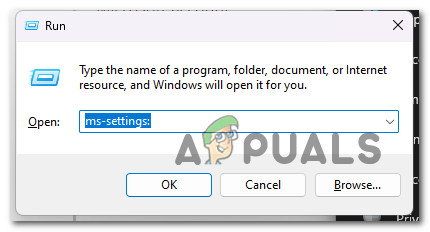
Access the Settings menu on Windows 11 - Once you are prompted by the User Account Control, click Yes to grant admin access.
- Once you’re inside the Settings menu, use the side menu on the left to click on Accounts.
- From the accounts menu, move over to the right-hand side menu and see if the Verify hyperlink is visible.
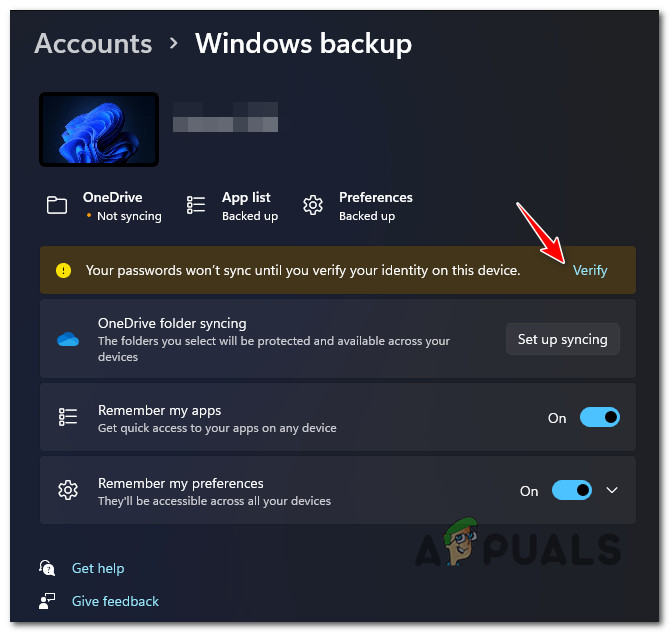
Verify the account Note: If you don’t see the ‘Your password won’t sync until you verify your identity on this device’ message, your account is already verified.
- Click on Verify, then follow the instructions below to complete the verification process.
- Reboot your PC and wait until the next startup is complete, then see if you’re still seeing the ‘Sign in with Your Microsoft Account to Continue App Experience’ error.
If the same kind of issue is still occurring, move down to the next method below.
2. Update the Windows version to the latest
You should begin your troubleshooting process with this if you haven’t updated your Windows 11 PC in a while. Since Microsoft has already released an update to address this issue, all you need to do in this situation is enter the Windows Update menu and install all the pending Windows 11 updates.
Microsoft has resolved a problem that some Windows 11-powered devices had as a result of a faulty Windows update that caused some Settings dependencies to become corrupted. You must install every pending Windows Update in order to ensure that the hotfix is installed, as Microsoft has previously released a few hotfixes for this issue.
Make sure you have the most recent Windows infrastructure updates installed if you have a high-end PC. You should take this action if you frequently experience this issue when using your PC for resource-intensive tasks.
If your Windows system is lacking any essential infrastructure upgrades, updating Windows 11 may eventually allow you to prevent the ‘Sign in with Your Microsoft Account to Continue App Experience’ from appearing again.
For thorough directions on how to achieve this on Windows 11, continue reading:
- One way to launch Windows Update is using the Run dialog box.
- Press the Windows key and R on your keyboard to do this. As a result, the Run dialog box will show up.
- After that, enter “ms-settings:windowsupdate” into the text box. This will take you to the Windows Update area of the Settings app.

Access the Windows Update menu Note: If you haven’t changed the UAC Settings, you can receive a prompt asking for your permission to continue. Clicking Yes indicates that you are in agreement with this.
- Select Check for Updates from the menu on the right after accessing the Windows Update pane.

Checking for updates - Select Install Now to start a local installation after the update has finished downloading.
- Check to see if the problem has been fixed by restarting your computer.
Continue to the next step if you’re still seeing the ‘Sign in with Your Microsoft Account to Continue App Experience’ when opening the Settings menu.
3. Disable Proxy or VPN settings
It turns out that the cause of this error message in the Windows 11 Settings menu is frequently proxy servers and VPN services. If you’re utilizing Windows 11’s native proxy or VPN options, this is far more likely to happen. You only need to turn off the VPN or proxy components to solve this problem and then check to see whether the error still occurs.
If none of the aforementioned techniques worked for you, you might want to think about disconnecting from any active VPN or proxy connections on your computer.
Windows 11 doesn’t work well with VPN or proxy servers. And it turns out that many anonymity services are expressly forbidden from exchanging data.
A number of impacted users have stated that the only way they were able to fix the problem was by turning off the proxy server or VPN client they were using.
If this approach applies to you, we have two distinct guides that will show you how to stop your VPN or proxy server.
3.1. Disable Proxy server
If you’re using a proxy server, you’ll need to manually close the connection by going to the Proxy menu in the Window Setting menu.
This is how:
- Press the Windows key + R to launch the Run dialog box.
- Next, launch the Settings app’s Proxy tab by typing “ms-settings:network-proxy” and pressing Enter.
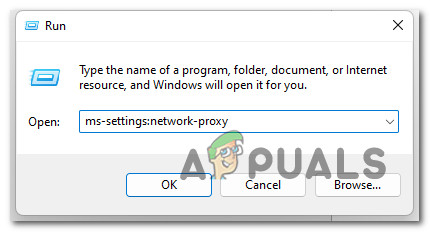
Accessing the Proxy server - Scroll down to the Manual Proxy Setup section in the Settings menu’s Proxy tab.
- Next, move to the screen’s right side and uncheck the box next to Use a proxy server.
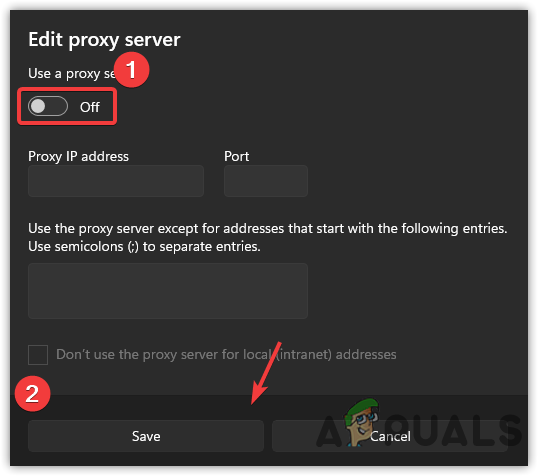
Disable the Proxy server - Restart your computer to see if the issue is fixed when it starts up again after you’ve successfully disabled the proxy server.
3.2. Disable VPN server
Depending on the type of implementation you’re using, you may be able to disable the VPN client. The VPN connection must be turned off from the dedicated settings menu if a desktop VPN client was installed.
On the other side, here is a simple tutorial on how to disable a VPN connection that you have configured with a Windows 10 built-in feature:
- To enter the Run dialog box, first, press Windows key + R to open up the Run dialog box.
- Next, open the VPN tab of the Settings app on your Windows computer by typing “ms-settings:network-vpn” and pressing Enter.

Accessing the VPN client - To stop your VPN from interfering with the Settings app, click your VPN in the right-hand area of the VPN connection tab, then choose Remove from the context menu.

Remove the VPN connection
Continue to the next potential solution below if the issue is still not resolved.
4. Reset the Windows Store
One situation that is frequently disregarded involves corruption that affects data that the Windows Store has accumulated in its cache. Resetting the entire Windows Store component has been reported to work by several users with whom we have previously dealt with similar problems.
It turns out that this problem could also be brought on by a form of corruption that prevents your PC from establishing connections with Microsoft servers and your integrated UWP store. The majority of the time, temporary files kept in the cache folder are the cause of this issue.
This kind of issue often arises after an unexpected machine interruption or after the security scanner ends up quarantining specific objects. Botched updates are an uncommon but potential reason why the “Sign in with Your Microsoft Account to Continue App Experience” problem can appear.
Many Windows users who were experiencing the same issue have claimed that they were able to fix it by restarting Windows Store and all related components.
There are two methods for clearing the Windows Store cache on Windows 10. Keep that in mind. Although the first alternative is simpler, it involves using a CMD terminal to execute a number of instructions. However, if you’re not confident with CMD commands, you can also choose the GUI-exclusive option, in which case you can only carry out the desired action from the Windows settings menus.
You are free to use whichever approach makes you feel the most comfortable:
4.1. Reset Windows Store via Settings
This is the easier option out of the two. However, depending on the degree of corruption that is currently affecting your PC, you might not be able to follow this method.
But if you can access the Settings menu, go for the steps below:
- To bring up the Run dialog box, press the Windows key + R. Next, enter “ms-settings:appsfeatures” and click Enter to launch the Settings app’s Apps & Features panel.
- After successfully entering the Apps & Features screen, find the Microsoft Store entry in the list of installed UWP applications by scrolling down.
- After you locate the Microsoft Store application, select the hyperlink for the Advanced option (under Microsoft Corporation).
- Once you’ve accessed the Advanced settings menu, go down to the Reset tab, click the Reset button, and the cache-clearing procedure will start.
- After this procedure is finished, reboot your computer and check to see if the issue is fixed during the subsequent starting phase.
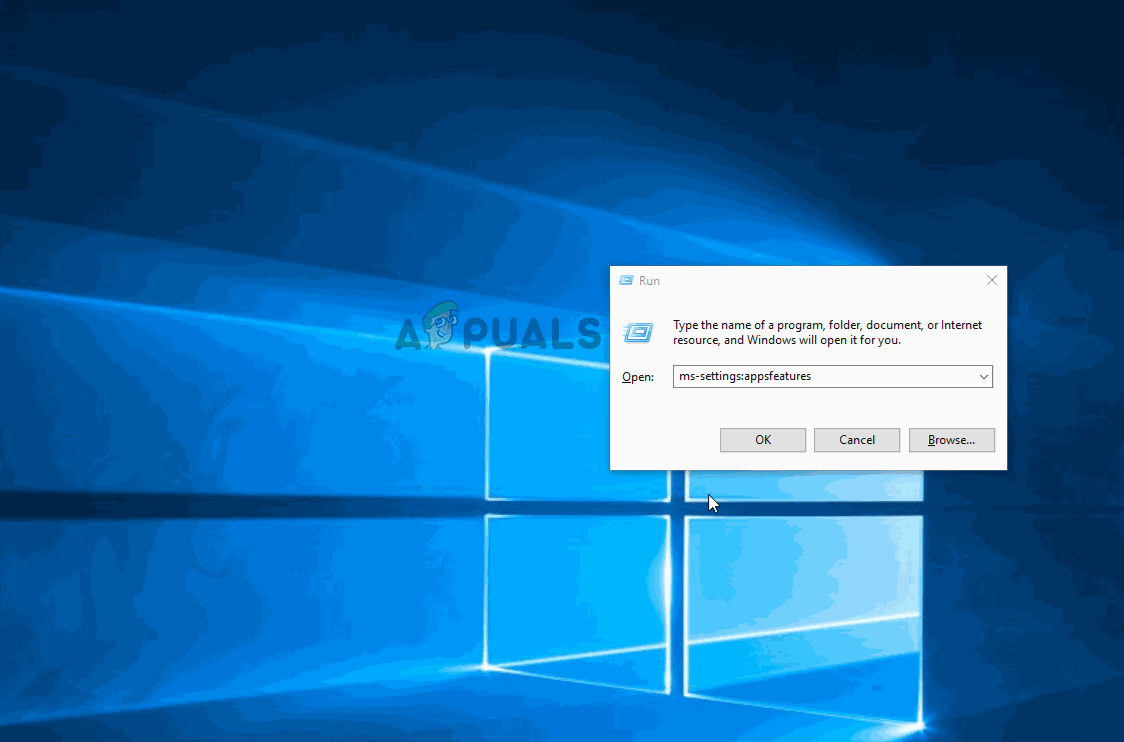
4.2. Reset Windows Store via CMD
If you’re experiencing problems with the Settings menu, the best course of action would be to carry on the reset procedure from an elevated CMD prompt.
Here’s how to do this:
- To bring up the Run dialog box, press the Windows key + R. Then, enter “cmd” into the text box and click Ctrl + Shift + Enter to launch an administrator Command Prompt. Click Yes to grant admin access when the UAC (User Account Control) prompt appears.

Open a CMD prompt - To reset the Windows Store and all dependencies, execute the following command and press Enter once you’ve managed to open the elevated Command Prompt:
wsreset.exe
- Restart your computer after the command has been successfully executed to check if the problem has been fixed when the system starts up again.
5. Create a new Windows Account
The problem can be due to some sort of corruption that surfaced during the upgrading process if you recently switched from Windows 10 to Windows 11 and experienced it right away. Other customers who also experienced this issue have reported that switching to a different Windows account resolved the issue.
According to numerous affected users, this issue may also occur because your currently logged-in Windows account is corrupt, according to many people who have encountered it. It has been reported by a number of worried people who were having the same type of problem that they were able to fix it by either opening a new account or switching to a local account.
It has been reported by a number of worried people who were having the same type of problem that they were able to fix it by either opening a new account or switching to a local account.
Create a new Windows account (it can be local) and restart the remote desktop service to make sure the problem isn’t your present account.
It’s critical to remember that performing this procedure will delete all corrupted dependencies connected to your current user profile.
By utilizing the steps listed below to create a new user account, you can completely prevent the ‘Sign in with Your Microsoft Account to Continue App Experience’ error:
- To launch the Run dialog box, press the Windows key + R.
- Next, enter “ms-settings:otherusers” in the text area and press Enter to launch the Family & Other People tab in the Settings app.
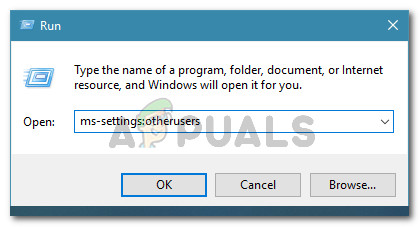
Accessing the Other users tab - From the Family & other users menu, choose to Add someone else to this PC on the Other Users page.
- You can determine if the remote service can be started normally by finishing the remaining steps to create a new Windows account, rebooting your computer, and login in with the new account.
If the “Sign in with Your Microsoft Account to Continue App Experience” issue still exists, proceed to the next method below.
6. Clean boot your PC
This error message may be indirectly brought on by software you previously installed on your Windows 11 PC, depending on which 3rd-party apps and services are set up to execute at every startup. Reach a clean boot state and check to see if the error notice stops appearing to verify whether this theory is accurate.
If you only experience this issue sometimes, it’s possible that a third party is interfering with your computer and causing this type of BSOD.
It’s impossible to build a thorough list of all probable culprits, therefore the best thing you can do is perform a clean boot, and then gradually activate each service, beginning item, or process until you find the offender.
In this case, beginning in clean boot mode and following a set of instructions to check for a software conflict and identify the troublesome service or process should be able to fix the issue.
In order to provide a clean boot state and maybe prevent the emergence of this problem, your computer will boot without any third-party services, processes, or startup items.
This article offers step-by-step instructions for reaching this clean boot condition.
If achieving a clean boot state didn’t help your cause, move down to the next method below.
7. Perform SFC and DISM scans
Some people claim that system file corruption, a Windows function that uses a lot of resources, can cause this problem. A lot of time, the ‘Sign in with Your Microsoft Account to Continue App Experience’ is encountered on low-end PCs that don’t have a lot of system resources to work with.
By using SFC (System File Checker) and DISM (Deployment Image Servicing and Management) to locate the damaged files at the heart of the issue and replace them with functional versions, the issue can be fixed.
Despite the fact that these two utilities have a lot of characteristics, they take different approaches to getting rid of corruption.
If you want to try this method, start with an SFC scan because DISM requires a Windows Update add-on while SFC uses a locally stored archive to download clean files.
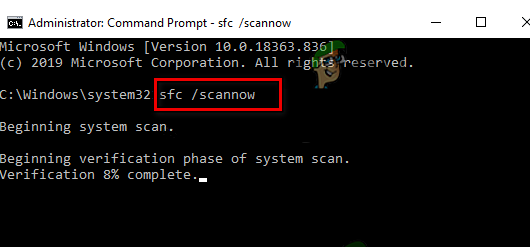
When the initial SFC scan is finished, restart your computer and perform a DISM scan.
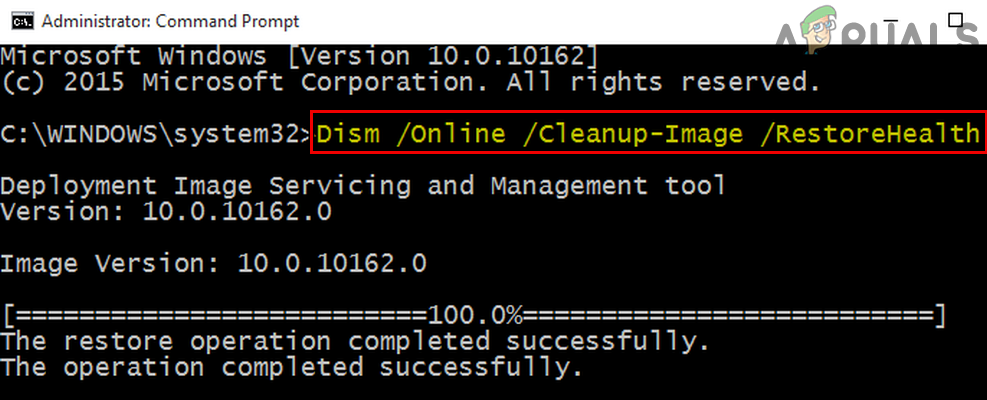
Note: Prior to beginning the DISM process, confirm that your Internet connection is steady.
Replace corrupted files by adhering to the on-screen directions if any of these tools are successful in locating and fixing an underlying corrupt issue.
Once the DISM scan has successfully concluded, restart your computer to see if the problem has been fixed.
If the same kind of problem is still occurring, move down to the final potential fix below.
8. Perform a clean install or repair install
If none of the possible solutions mentioned above worked for you, you might start to wonder if you might be dealing with a system file corruption that causes the ‘Sign in with Your Microsoft Account to Continue App Experiences’ error.
You have two options for moving ahead if you find yourself in this situation:
- Repair install – If you have the resources, we advise starting here. By employing this technique, you can update all of your system files without affecting your individual files or installations.
- Clean install – If you want to start over, performing a clean install is generally the best option. However, bear in mind that if you choose this course, you should anticipate losing any personal data on the OS drive (including media, games, documents, and applications)





